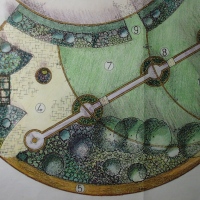 This is the second in my new series on garden trees. I’ll shortly be doing one or two articles about trees and garden design, in my series ‘Design my garden’, so keep an eye out.
This is the second in my new series on garden trees. I’ll shortly be doing one or two articles about trees and garden design, in my series ‘Design my garden’, so keep an eye out.
Common name: Silver Birch
Native areas: Europe, though in southern Europe it is only found at higher altitudes
Historical notes: Also known as the ‘Lady of the woods’ because of its slender and graceful appearance. Especially popular in the UK. Grown as an ornamental plant and also for its timber. It is used for a range of purposes, from broom-making and steeple-chase fencing to medicines.
Features: A medium tree (15- 20 metres tall), with a conical, semi weeping habit, with white bark and horizontal lines and large diamond -shaped cracks which form as the tree matures. Leaves ovate, yellow in autumn. Flowers in catkins. Can be grown either as a single or multi-stemmed tree.
This slideshow requires JavaScript.
Uses: Very good as a multi-stemmed tree for exposed or elevated positions as they have a low centre of gravity. These look good in small groups in informal settings. I have a few that contribute to a mixed ‘woodland edge’ here at Old School Garden, providing a natural boundary to the garden. It can also be used as a specimen, though some of the cultivars available perhaps provide more interesting features than the species plant:
‘Dalecarlica’ – (Swedish Birch, syn. ‘Laciniata’ or ‘Crispa’)- deeply cut leaves which weep gracefully, white peeling bark
‘Fastigiata’- stiffly ascending branches give it a columnar shape, resembling Lombardy Poplar
‘Purpurea’– slow growing and rare, with new, dark purple leaves,softening t o dark green/purple by summer.
‘Tristis’- tall (15-20 metres), weeping birch, with beautiful winter structure.
‘Youngii’- similar habit to ‘Tristis’ but shorter (5-10 metres) and so more suitable for smaller gardens, especially good as a specimen in lawns.
‘Zwisters Glory’- from Switzerland, this new variety has gleaming white bark, so makes a good avenue tree and a good choice for urban areas and is quick growing.
Two other species of birch are also worth mentioning:
Betula pubescens- ‘Common White Birch’, prefers damper conditions than B. pendula, also it’s more hardy. It’s ascending branches give it a more solid appearance than B. pendula.
Betula utilis ‘Jacquemontii’/ ‘Doorenbos’-a medium tree with ascending branches, most admired for its almost pure white bark, looking very effective against a dark background.

Betula pendula ‘Fastigiata’

Betula pendula ‘Youngii’

Betula pendula ‘Laciniata’ leaves
Growing conditions: grows well in most soils and is good for parks and woodland, but is not suitable for areas which have soil that becomes compacted. Difficult to transfer as a bare rooted specimen, but containerised plants are more successful.
Further information:

- Silver Birch among others in the snow at Old School Garden, January 2013
Old School Gardener
 This is the second in my new series on garden trees. I’ll shortly be doing one or two articles about trees and garden design, in my series ‘Design my garden’, so keep an eye out.
This is the second in my new series on garden trees. I’ll shortly be doing one or two articles about trees and garden design, in my series ‘Design my garden’, so keep an eye out.










We’ve just had a fairly big but alarmingly leaning Silver Birch felled. Even several weeks later, the stump continues to weep disgusting yellowy-white sap, which is forming dripping tendrils, like a wax candle, from the ends of which water is dripping, presumably as the roots continue to draw moisture from the ground. Very weird!
Interesting- any pics? Sounds like a case of natural ‘garden art’- see my post this Sunday for some other examples!
Wonderful. Thanks.
Thanks for reading it 🙂